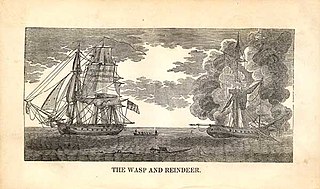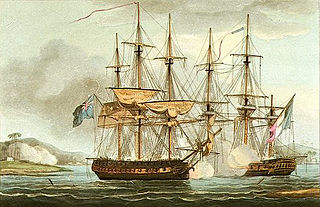Three vessels of the Royal Navy have borne the name HMS Mignonne, which means "dainty" in French.

HMS Reindeer was a Royal Navy 18-gun Cruizer-class brig-sloop of the Royal Navy, built by Samuel & Daniel Brent at Rotherhithe and was launched in 1804. She was built of fir, which made for more rapid construction at the expense of durability. Reindeer fought in the Napoleonic Wars before succumbing in 1814 to the guns of USS Wasp during the War of 1812.

HMS Mermaid was a 32-gun Active-class fifth-rate frigate of the Royal Navy, launched in 1784 and broken up in 1815. During the French Revolutionary Wars she served in the West Indies, the Channel, and the Mediterranean. During the Napoleonic Wars she first served in the Americas, but from early 1811 on, she was armed en flute and served as a troopship until she was broken up.

Chiffonne was a 38-gun Heureuse-class frigate of the French Navy. She was built at Nantes and launched in 1799. The British Royal Navy captured her in 1801. In 1809 she participated in a campaign against pirates in the Persian Gulf. She was sold for breaking up in 1814.

HMS Hazard was a 16-gun Royal Navy Cormorant-class ship-sloop built by Josiah & Thomas Brindley at Frindsbury, Kent, and launched in 1794. She served in the French Revolutionary Wars and throughout the Napoleonic Wars. She captured numerous prizes, and participated in a notable ship action against the French frigate Topaze, as well as in several other actions and campaigns, three of which earned her crew clasps to the Naval General Service Medal. Hazard was sold in 1817.

HMS Epervier was a French 16-gun Alcyon-class brig. HMS Egyptienne captured her in the Atlantic Ocean on 27 July 1803; she was taken into Royal Navy service under her existing name. Before being broken up in 1811 she captured several prizes and was present at the Battle of San Domingo. Her crew received a clasp to the Naval General Service Medal for their participation in that battle and another for an action in December 1808. She was laid up in late 1810 and was sold in 1811.

Sylphe was an Abeille-class 16-gun brig-corvette of the French Navy. The class was built to a design by François Pestel. The British captured her in 1807 and took her into the Royal Navy as HMS Seagull, but apparently never used her in any capacity. She was sold in 1814.

HMS Alacrity was a Cruizer-class brig-sloop built by William Rowe at Newcastle and launched in 1806. She served in the Baltic and was at the capture of Copenhagen in 1807. She captured a large privateer before herself falling victim to a French man-of-war in 1811 in an action in which her captain failed to distinguish himself. She then served in the French navy until she was broken up in 1822.
HMS Harrier was a Cruizer-class brig-sloop launched in 1804. She took part in several notable actions before she was lost in March 1809, presumed foundered.

The French frigate Alcmène was an Armide-class frigate of a nominal 44 guns, launched in 1811. The British captured her on 1814. The Royal Navy named her HMS Dunira, and then renamed her HMS Immortalite but never commissioned her nor fitted her for sea. In March 1822 she became a receiving ship at Portsmouth. She was sold in January 1837.

The French brig Voltigeur was a Palinure-class brig launched in 1804. The British captured her in 1806 and renamed her HMS Pelican. She was sold in 1812.
HMS Cerbere was the French naval brig Cerbère, ex-Chalier, which the British captured in 1800. She was wrecked in 1804.

HMS Swallow was a Cruizer-class brig-sloop launched in December 1805, nine months late. She served the Royal Navy through the Napoleonic Wars, capturing numerous privateers. After the end of the wars she was broken up in 1815.
HMS Spencer was a 16-gun brig-sloop of the Royal Navy, formerly the civilian Sir Charles Grey. The Admiralty purchased her in 1795, after having hired her in 1793-94, and renamed her HMS Lilly in 1800. The French privateer Dame Ambert captured her in 1804 and Lilly became the French privateer Général Ernouf. She blew up in 1805 while in an engagement with HMS Renard.

Diligente was a French Navy Naïade-class corvette, launched in 1794 as a brig. HMS Crescent captured her in the Antilles in 1800. The British took her into service as a 14-gun transport and sold her in 1814.
The French schooner Découverte was a French Navy vessel launched in 1800. The British captured her at Santo Domingo in 1803 and took her into service as HMS Decouverte. She was decommissioned in January 1806 and sold in 1808.
HMS Cerf was the Spanish Navy's 18-gun brig Cuervo, built at Havana in 1794-95. A British privateer captured her and her captors renamed her Stag before in December 1801 selling her to the Captain-General of Guadeloupe. The French Navy took her into service as the 14-gun brig Cerf. The Royal Navy acquired Cerf at the surrender of Santo Domingo on 30 November 1803. The Royal Navy sold her in 1806.
The French brig Nisus was a Palinure-class brig of the French Navy, launched in 1805. The Royal Navy captured Nisus at Guadeloupe in 1809. The British took her into service as HMS Guadaloupe, and sold her in November 1814.
The French brig Observateur, which was launched in 1800 for the French Navy, was a Vigilant-class 16-gun brig, one of six built to a design by Pierre-Alexandre-Laurent Forfait. The Royal Navy captured her in 1806 and took her into service as HMS Observateur. She participated in two actions, one for the French Navy and one for the Royal Navy, and one campaign before she was laid up in 1810. The Navy did not succeed in selling her until 1814.
HMS Vimiera was launched in 1805 at Havre as the French Navy brig Pylade. The Royal Navy captured her in 1808 and commissioned her. She participated in one campaign that earned her crew a clasp to the Naval General Service Medal. She was laid up in 1810 and sold in 1814.










